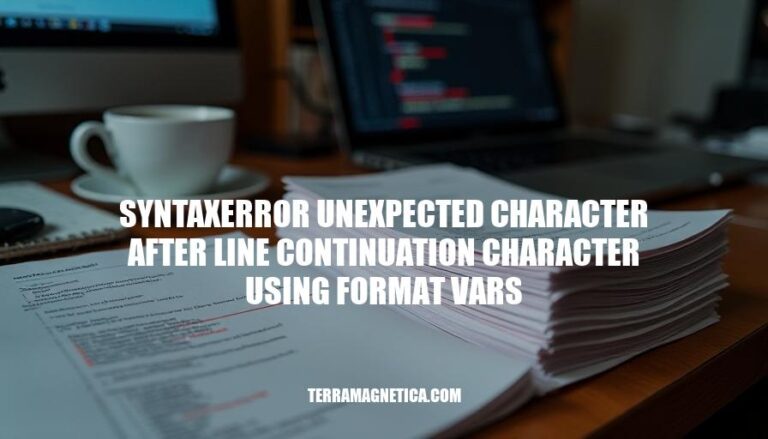


In Python programming, encountering the SyntaxError: unexpected character after line continuation character can be confusing, especially when using format variables. This error typically occurs when there’s an unintended character or whitespace after a backslash (\), which is used for line continuation. Understanding this error is crucial as it helps maintain clean, readable code and prevents runtime issues that can disrupt the execution of your programs.
Definition: The SyntaxError: unexpected character after line continuation character occurs in Python when there is an invalid character or whitespace after a line continuation character (\).
Common Scenarios:
Trailing Characters:
total = 10 + \
5 # Invalid space after backslash
Using Backslash for Division:
result = 10 \ 2 # Incorrect use of backslash instead of division operator
String Continuation:
text = "Hello, " \
"world!" # Ensure no characters after backslash
Incorrect Indentation:
if True:
print("Hello, world!") \
print("This will cause an error") # Incorrect continuation
These scenarios highlight common mistakes leading to this error.
The SyntaxError: unexpected character after line continuation character occurs when there are characters or whitespace after a line continuation character (\). Here are specific causes and examples:
Whitespace after the backslash:
total = 1 + 2 + \
3 + 4 + \ 5
# SyntaxError: unexpected character after line continuation character
Characters after the backslash:
total = 1 + 2 + \
3 + 4 + \5
# SyntaxError: unexpected character after line continuation character
Using backslash incorrectly in strings:
text = "This is a long string that needs to be split \
into two lines"
# SyntaxError: unexpected character after line continuation character
Incorrect use in mathematical operations:
result = 10 / \
2 / \ 3
# SyntaxError: unexpected character after line continuation character
These examples illustrate common mistakes that trigger this error.
Remove Characters After Line Continuation:
# Incorrect
print("Hello, world!\") print("Another line")
# Correct
print("Hello, world!\")
print("Another line")
Use Proper Division Operator:
# Incorrect
result = 10 \ 2
# Correct
result = 10 / 2
Avoid Trailing Whitespace:
# Incorrect
print("Hello, world!\")
# Correct
print("Hello, world!\")
black or autopep8 to automatically format your code.These steps should help you fix and avoid the “SyntaxError: unexpected character after line continuation character” in the future.
occurs when there are characters or whitespace after a line continuation character (“) in Python. This can happen due to:
Consistent code formatting, regular code reviews, IDE/editor configuration, and unit testing are also essential best practices to prevent syntax errors in Python programming.